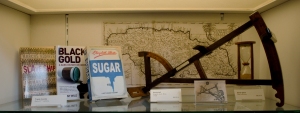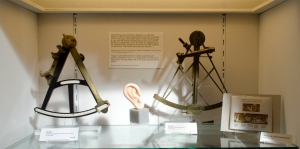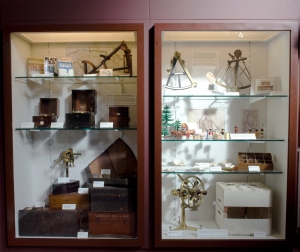In 2012 I curated an exhibition in two cabinets for long-term display at the Whipple Museum of the History of Science, University of Cambridge. This brought together research on the material holdings of the Whipple Museum with the results of research I had undertaken on the archives of the Board of Longitude as a postdoctoral researcher on the AHRC-funded project The Board of Longitude 1714-1828: Science, Innovation and Empire in the Georgian World.
I used quotations directly from manuscript and print sources in the Board of Longitude archive to interpret and contextualise navigational and astronomical instruments. The exhibition is called Navigation and Commerce: Their Original and Progress, a title borrowed from John Evelyn’s 1674 book of the same name, in which Evelyn famously claims that “whoever commands the ocean, commands the trade of the world”. The exhibition sought to emphasise mercantile motivations for improvements to navigation, with gestures to, for instance, the sugar trade, slavery, and (sometimes violent) encounters with indigenous peoples. The exhibition furthermore emphasises that the success or failure of astronomical and navigational instruments lies in their ability to be stored and transported, and so packaging, boxes, locks, keys and cargo crates are incorporated throughout.

Charles Mason and Jeremiah Dixon, English astronomers, surveying the boundary between Pennsylvania and Maryland, and undertaking gravitational experiments with a pendulum clock supplied by the Royal Society of London, 1765

The fate of most scientific instruments is to be used, broken, recycled, and lost. Museum collections likewise are full of broken, incomplete and unclearly provenanced objects

“Sailors are such a rough hands that they would make no difference between a cask of herrings and the cases containing the circle and clock.”
Navigational and astronomical hardware only has value if it can be securely stored and transported. The same is often true of museum objects
The Whipple Museum of the History of Science in Cambridge is open Monday to Friday, 12:30 PM until 4:30 PM. Please come and see my exhibition in the flesh!
A discussion between me and Katy Barrett about boxes in museums:
http://storestoriescambridge.wordpress.com/2013/07/08/to-box-or-not-to-box/
Some thoughts by Richard Morrison on broken stuff in museums:
http://www.rmorrison.net/mnemozzyne/news-flash-broken-stuff-continues-to-exist






I’m delighted that you recognized the importance of sugar in this story.
thanks Deborah, very pleased that you agree!
Pingback: Whewell’s Gazette: Year 03, Vol. #24 | Whewell's Ghost